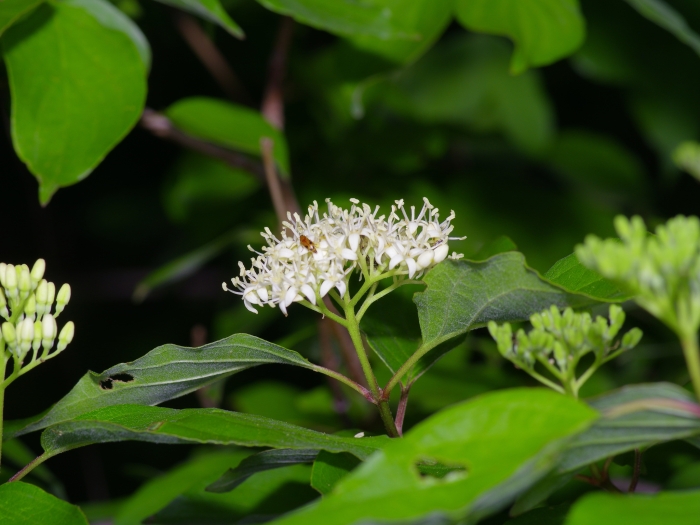Roughleaf Dogwood
(Cornus drummondii)
Roughleaf Dogwood (Cornus drummondii)
/
/

Michelle W.
CC BY 4.0
Image By:
Michelle W.
Recorded By:
Copyright:
CC BY 4.0
Copyright Notice:
Photo by: Michelle W. | License Type: CC BY 4.0 | License URL: http://creativecommons.org/licenses/by/4.0/ | Rights Holder: Michelle W. | Publisher: iNaturalist | Date Created: 2021-04-25T03:33:59-07:00 |




















































Estimated Native Range
Summary
Cornus drummondii, commonly known as Roughleaf Dogwood, is a small deciduous shrub or tree native to the central and eastern United States, particularly within the Great Plains and Midwestern regions, as well as along the Mississippi River. It thrives in a variety of habitats, including forest edges, open woodlands, and along streams and rivers, where it often forms dense thickets. Roughleaf Dogwood typically reaches a height of 15 to 25 feet (4.6 - 7.6 m) with a spread of 10 to 15 feet (3.1 - 4.6 m), featuring a rounded form with horizontal branching. During the summer months, it produces clusters of creamy white flowers that are modestly showy, followed by small, white, berry-like drupes that ripen from August to October and are attractive to wildlife.
The Roughleaf Dogwood is valued for its wildlife benefits, as it provides cover and its fruits are consumed by over forty species of birds. It is used in cultivation for buffer strips around parking lots, highway medians, and residential areas near decks and patios. This species is adaptable to a range of soil types, prefers full sun to part shade, and has low water requirements once established. It is also used for erosion control due to its suckering habit, which helps stabilize soil. While generally low-maintenance, it can be susceptible to dogwood anthracnose and powdery mildew. Pruning may be necessary to maintain a tidy appearance and promote good air circulation to minimize disease risk.CC BY-SA 4.0
The Roughleaf Dogwood is valued for its wildlife benefits, as it provides cover and its fruits are consumed by over forty species of birds. It is used in cultivation for buffer strips around parking lots, highway medians, and residential areas near decks and patios. This species is adaptable to a range of soil types, prefers full sun to part shade, and has low water requirements once established. It is also used for erosion control due to its suckering habit, which helps stabilize soil. While generally low-maintenance, it can be susceptible to dogwood anthracnose and powdery mildew. Pruning may be necessary to maintain a tidy appearance and promote good air circulation to minimize disease risk.CC BY-SA 4.0
Plant Description
- Plant Type: Tree, Shrub
- Height: 6-15 feet
- Width: 6-15 feet
- Growth Rate: Rapid
- Flower Color: White
- Flowering Season: Spring
- Leaf Retention: Deciduous
Growth Requirements
- Sun: Full Sun, Part Shade
- Water: Medium, High
- Drainage: Medium, Slow
Common Uses
Bee Garden, Bird Garden, Border Plant, Butterfly Garden, Deer Resistant, Erosion Control, Fragrant, Hedges, Hummingbird Garden, Rabbit Resistant, Showy Flowers, Street Planting
Natural Habitat
Native to central and eastern United States, thriving in forest edges, open woodlands, and riparian areas
Other Names
Common Names: Drummond’s Dogwood, Rough-Leaved Dogwood, Cornouiller De Drummond
Scientific Names: , Cornus drummondii, Cornus asperifolia var. drummondii, Swida drummondii, Cornus priceae, Cornus drummondii f. priceae, Swida priceae, Thelycrania priceae,
GBIF Accepted Name: Cornus drummondii C.A.Mey.